Early in the morning in the Kenyan bush, the human and other mammalian residents and visitors of Ol Pejeta Conservancy (or “OPC”) are getting watered, fed and ready for a new day. There are numerous conservancy staff members and a handful of researchers: PhD students preparing for careers in animal behaviour and conservation, teams of Earthwatch volunteers and their leaders and other visiting scientists, all of whom are contributing to our knowledge about and welfare of the many mammal species who call this equatorial landscape home. And there we are thrown into the mix: Dr. Briana Pobiner (Smithsonian Institution, National Museum of Natural History) and Dr. Kris “Fire” Kovarovic (Durham University, UK). We aren’t conservationists and we aren’t often focused on the present. We can be variously described as archaeologists, paleoanthropologists, paleontologists, and paleoecologists; broadly speaking we are interested in human evolutionary history and how we evolved in the context of past environments.
We aren’t at OPC to study wildlife in the flesh; instead, we are interested in their bones that accumulate naturally on the ground after death. The objects of our study are often curiously regarded by the other researchers, if not considered somewhat inelegant by those who, rightly so, are awe-inspired and deeply committed to the living objects of their own study. We are not infrequently asked: “What are two people who study human prehistory doing looking at bones of dead animals?” That’s a good question, and the answer rests upon the connection drawn between modern bones on the ground and their fossil counterparts that are collected at palaeontological sites. If we can understand the processes that cause modern bones to deteriorate, accumulate and be buried in certain characteristic ways, or the taphonomy of these remains, we can interpret the same processes and their resultant patterns in assemblages of fossil bones. In 2007 we began our long-term project at OPC, BONES: Bones of Ol Pejeta: Neotaphonomic and Ecological Survey. Our aim is to understand the myriad ways in which a number of ecological characteristics condition bone accumulations.
_______________________________________________________________________________________________________________________
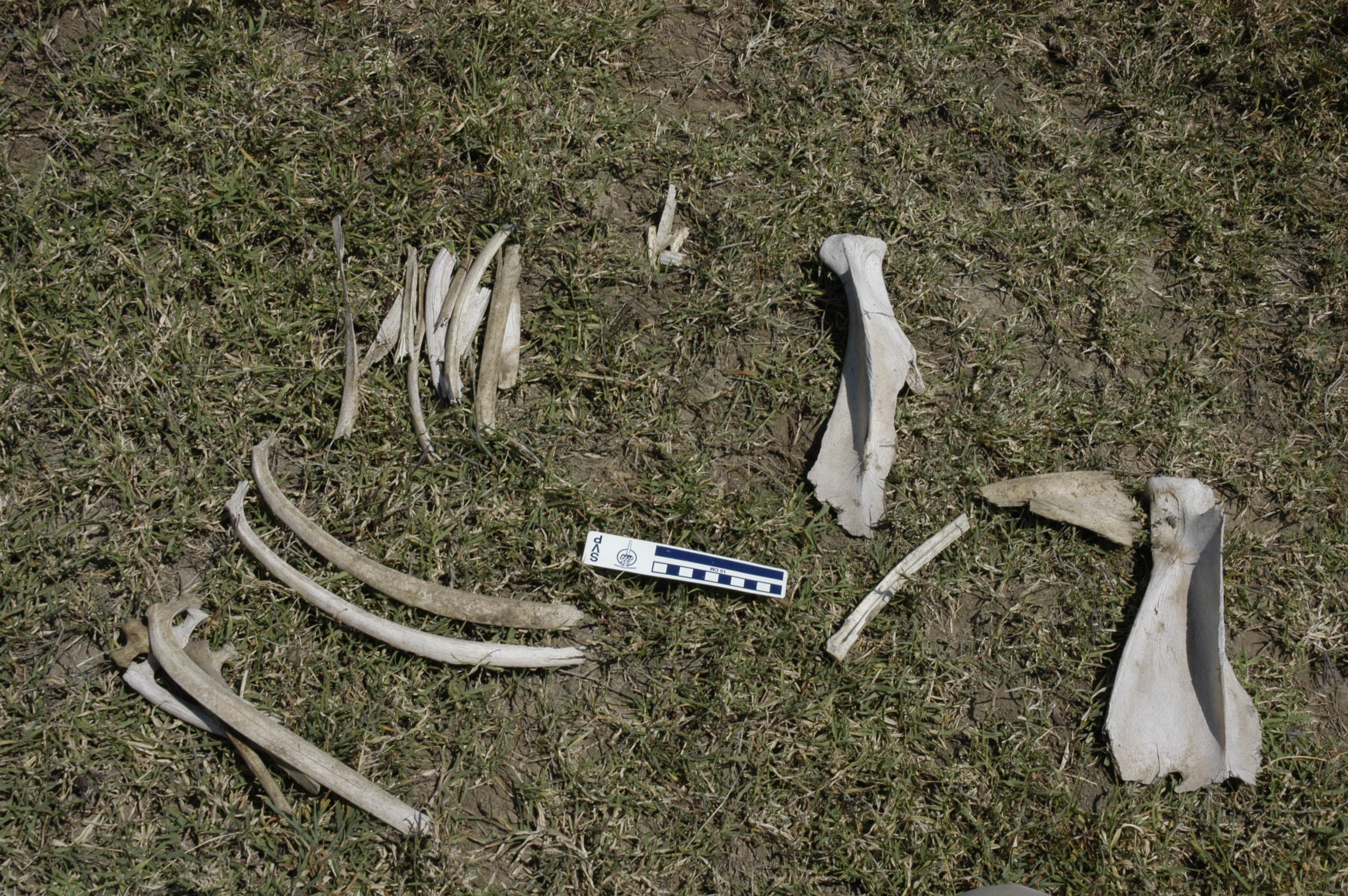
A scatter of bones found by Drs. Pobiner and Kovarovic during the summer of 2011 at OPC. Photo credit: Dr. Briana Pobiner
_______________________________________________________________________________________________________________________
How we relate mammal bones to environments is, however, another question we are often asked. It’s an important question and one that bears upon a major line of inquiry in the study of human evolution, which is aimed at determining how our hominin ancestors responded to climate change (e.g. Potts 1996; Bobe et al. 2002) in terms of both behavioral and morphological adaptations. We can only understand this if we can accurately reconstruct the environments at sites where hominin, or early human, fossils are found in the first place. Basic ecological theory can help us understand one major way in which mammals are important in this regard: the characteristics of a habitat determine which animals can live there successfully. Therefore, if we know what animals once lived in a particular place, we can glean some idea of what their habitat was like. Any habitat is characterised by both abiotic and biotic factors, such as the soil type, drainage patterns, features of the terrain (abiotic) and the vegetation and animal life present (biotic). These factors combine to provide two broad niches for each species to exploit. The spatial niche is quite literally the space in which a species lives, sleeps and moves around; the trophic niche is essentially the dietary preference of a species. For example, a moist forest habitat will support a number of arboreal species that live and feed on fruits and leaves in the trees. In contrast, a grassland habitat will have fewer of these species because trees are not well represented in the vegetation — but open country, terrestrial, grass-grazing species will be abundant. From the perspective of the fossil record, bones and teeth are clearly relevant for an interpretation of the ecological niches exploited by fossil mammalian communities. The bones of arms and legs will provide information about how and where a species moved or locomoted, or the spatial niche, since limbs that are adapted for swinging about in the trees will look quite different from those adapted to running around on the ground. The teeth and jaws will tell us something about what the species ate, or what trophic niche(s) they exploited, as again those adapted for a diet of meat will look very different from those best adapted to eating plants. Fossils of non-hominin animals are abundant and often well-preserved at Plio-Pleistocene (5 – 1.8 million years ago) sites in Africa, providing ample opportunity to explore past environmental conditions through a study of their remains.
______________________________________________________________________________________________________________________
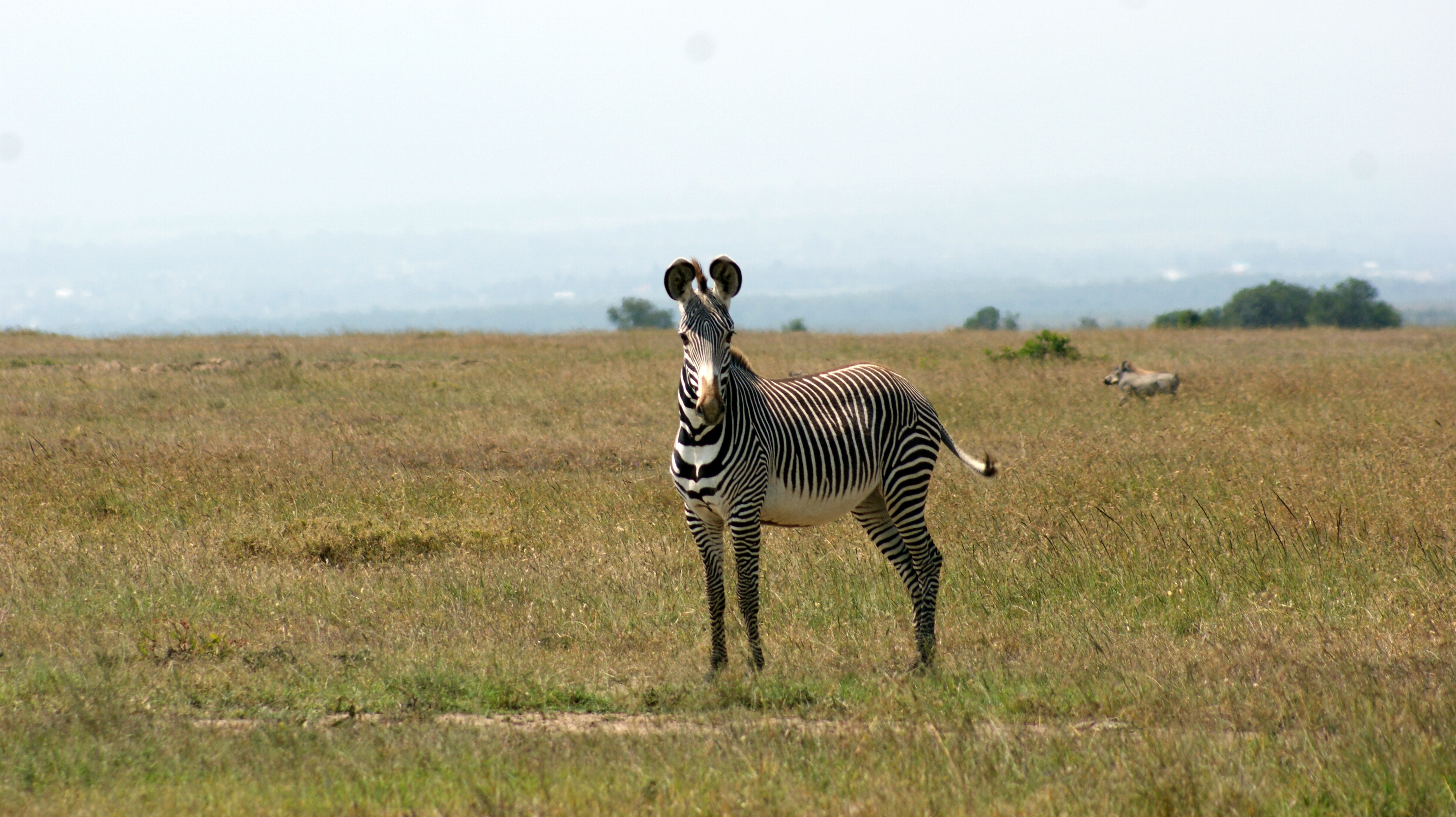
A Grevy’s zebra with a warthog in the background, both in their “typical” habitat: open grasslands. Photo credit: Dr. Nick Walton.
_______________________________________________________________________________________________________________________
We bring unique areas of scientific expertise to bear on the BONES project. One of us (Kovarovic) is an expert in understanding how the different species in a community exploit available niches, especially through the study of adaptive morphologies that can be linked specifically to the efficient exploitation of particular habitats, particularly in the mammalian family Bovidae (hooved, horned ungulates like gazelle, buffalo and related taxa). Evaluating such ecomorphologies is a routine method used in the reconstruction of paleoenvironments at hominin fossil sites (e.g. Kappelman 1991, Kappelman et al. 1997, Kovarovic & Andrews 2007). It has the advantage of not requiring identification of fossil mammal remains to the species or even genus level – what is important is not so much who the animals were, but for what they were adapted. Any fossil that retains ecomorphological information in an assemblage can be studied, so sample sizes tend to be large and therefore the statistical analyses more robust. The other of us (Pobiner) is a taphonomist, with a dual interest in how predator-prey relationships can be understood through an evaluation of the damage that carnivores do to the bones of their prey when they consume them as well as how bones naturally weather on the land surface. Tell-tale signs of carnivore activity, such as tooth punctures, pits and scores, as well as signs of gnawing, are used to determine overall predator pressure and in the fossil record contribute to our understanding of how and when hominins began competing with other carnivores for access to animal resources.
_______________________________________________________________________________________________________________________
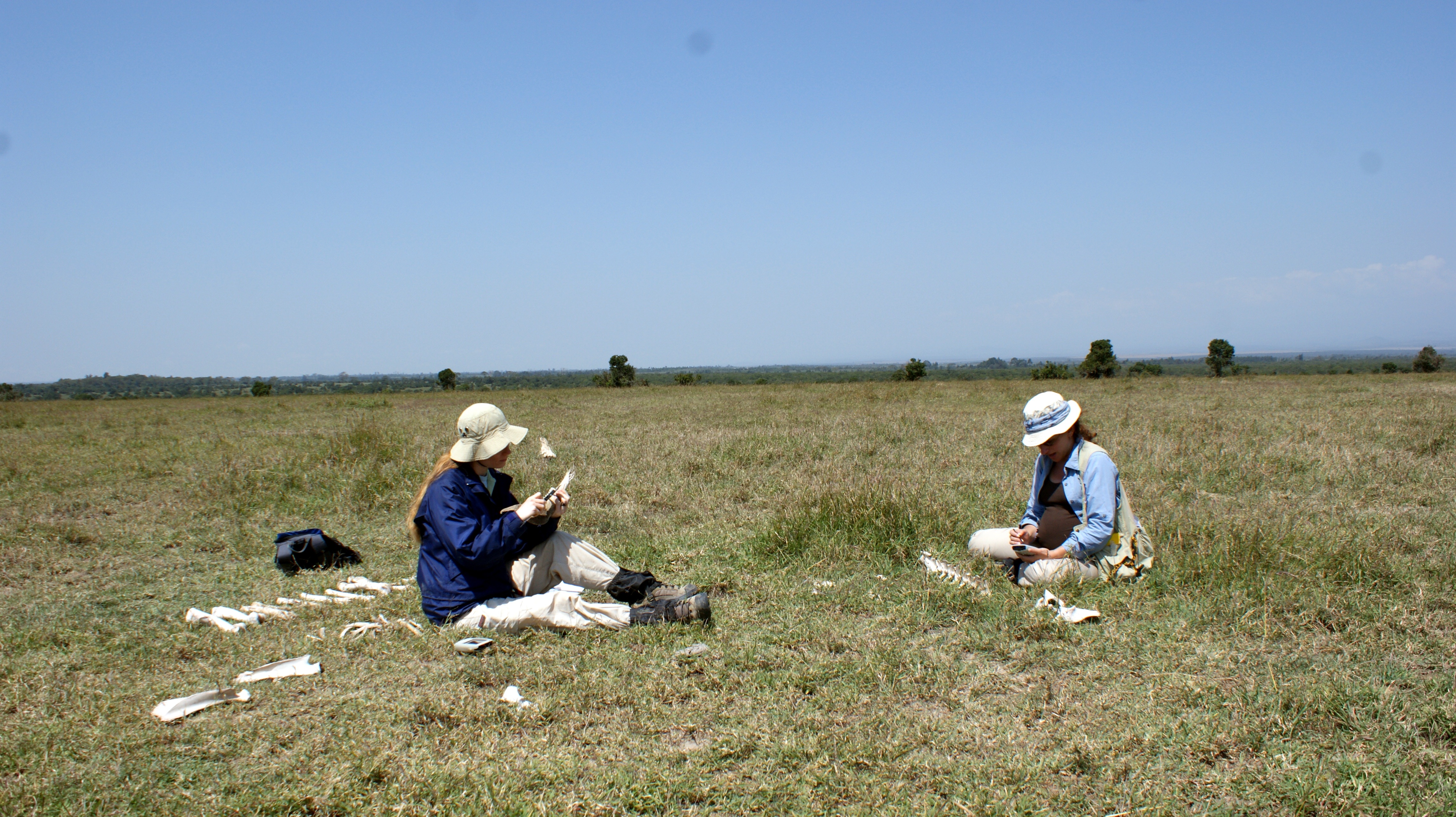
Drs. Kovarovic and Pobiner collecting data on a bone occurrence. Photo credit: Dr. Nick Walton.
_______________________________________________________________________________________________________________________
OPC is an excellent place to situate our BONES project for several reasons. It is a research-friendly environment, hosting a number of projects including a well-established Earthwatch project documenting the ecology of black rhinos. This team collects annual abundance data on the entire living mammal community as well as details of the regional vegetation associations and habitat distributions. Earthwatch Project Director, Dr. Geoffrey Wahungu (Moi University, Kenya) and OPC’s Ecological Monitoring Manager, Nathan Gichohi share detailed GIS habitat maps with us, which allow us to confidently associate bone accumulations to specific habitat types. They also share long-term (decade-scale) data on mammalian abundances, critical information that allows us to correlate the proportions of live animals with information derived from bone accumulations, such as predation patterns that can be reconstructed from studies of carnivore damage. In turn, we share our data and analyses, which facilitate OPC and Earthwatch’s work in monitoring living communities. Finally, the conservancy has presented us with a unique situation: a fence that previously divided a smaller wildlife reserve (formerly Sweetwaters Game Reserve) from a large cattle ranch (formerly Ol Pejeta Ranch) was taken down in 2007, and the whole area became one large conservancy. The wild animals living on both sides of the fence have been able to migrate to new areas and, as we’re not only interested in reconstructing environmental conditions at one time and place, but in tracing changes in such conditions, this provides us with an opportunity to see how quickly the “bone community” reflects known changes in the living animal community.
Each day in the field we follow an established protocol of walking along 1km transects looking for bones and documenting every one that we encounter (Behrensmeyer et al. 1979). We conduct these walking transects in each of the habitat types at OPC, collecting a variety of different types of data, including things like: (a) exact GPS location of every bone and bone scatter; (b) genus, species and body size of each bone occurrence, where possible; (c) weathering stage, which indicates how long the bone has been on the land surface (Behrensmeyer 1978), allowing us to establish a short term chronology of bone accumulation; (d) habitat information, including broad habitat type and local microenvironment; (e) indicators of carnivore damage which identify the predator species responsible for the kill (Haynes 1980, Pobiner & Blumenschine 2003, Pobiner 2007) and (f) ecomorphological data when the skeletal element is from a bovid (Kovarovic & Andrews 2007, Kovarovic unpublished). In the past, we’ve used old-fashioned paper and pencil to record our data, but this year our research colleague Dr. Nick Walton developed a fantastic digital data collection system tailored for our specific data types and research questions. Using iPaqs and bluetooth GPS units, we can now input all of our data directly into an electronic database while we are in the field, saving the time of later having to transcribe handwritten datasheets onto our computers. Each bone encounter that we record is automatically tagged with a date and time stamp and GPS location, so not only will mapping and spatial analyses be easier to conduct, but we can easily pull up details of the data we have collected each year, in each habitat or on each species.
_______________________________________________________________________________________________________________________
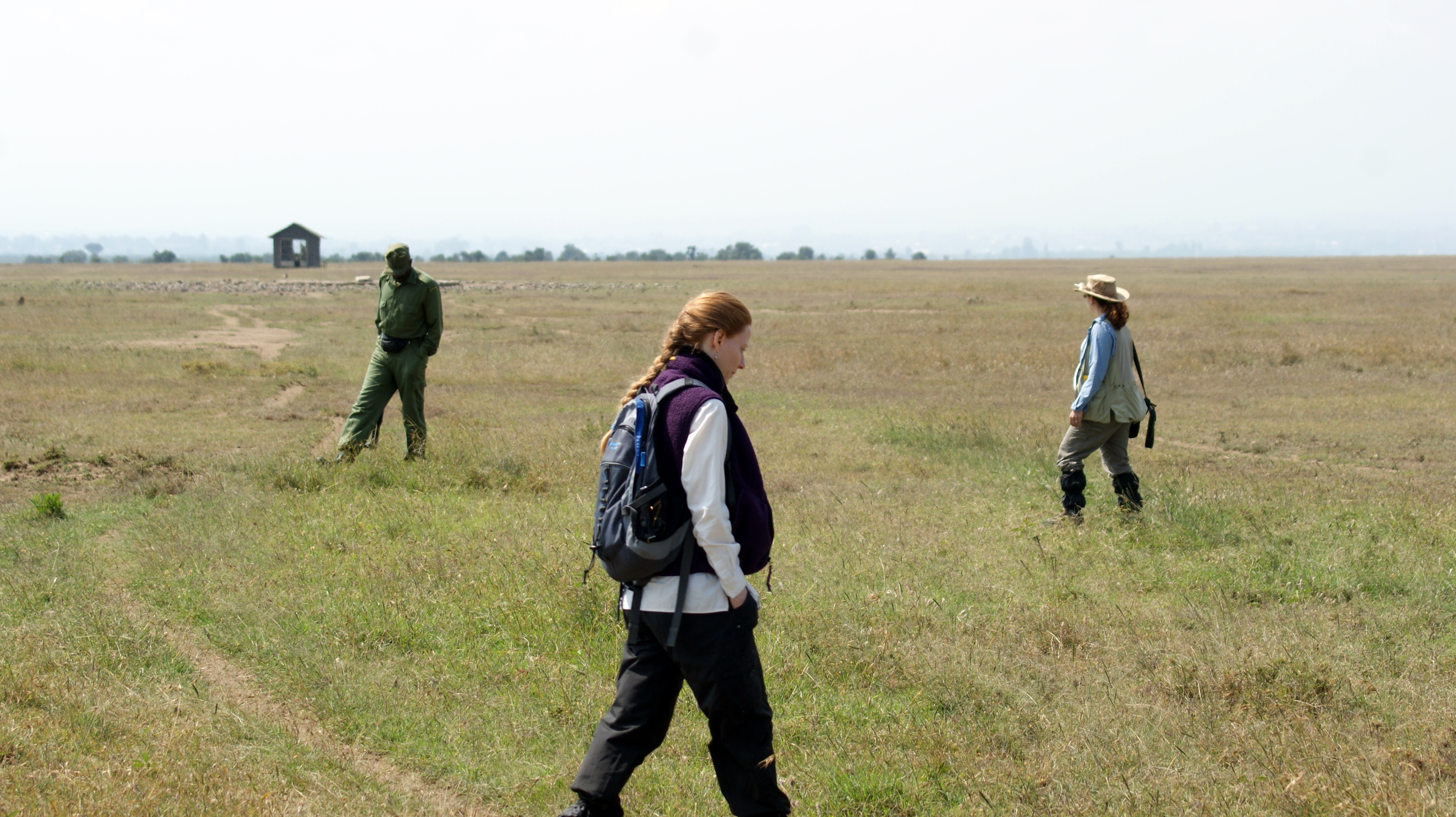
Drs. Kovarovic and Pobiner walking a bone transect with their armed guard. Photo credit: Dr. Nick Walton.
_______________________________________________________________________________________________________________________
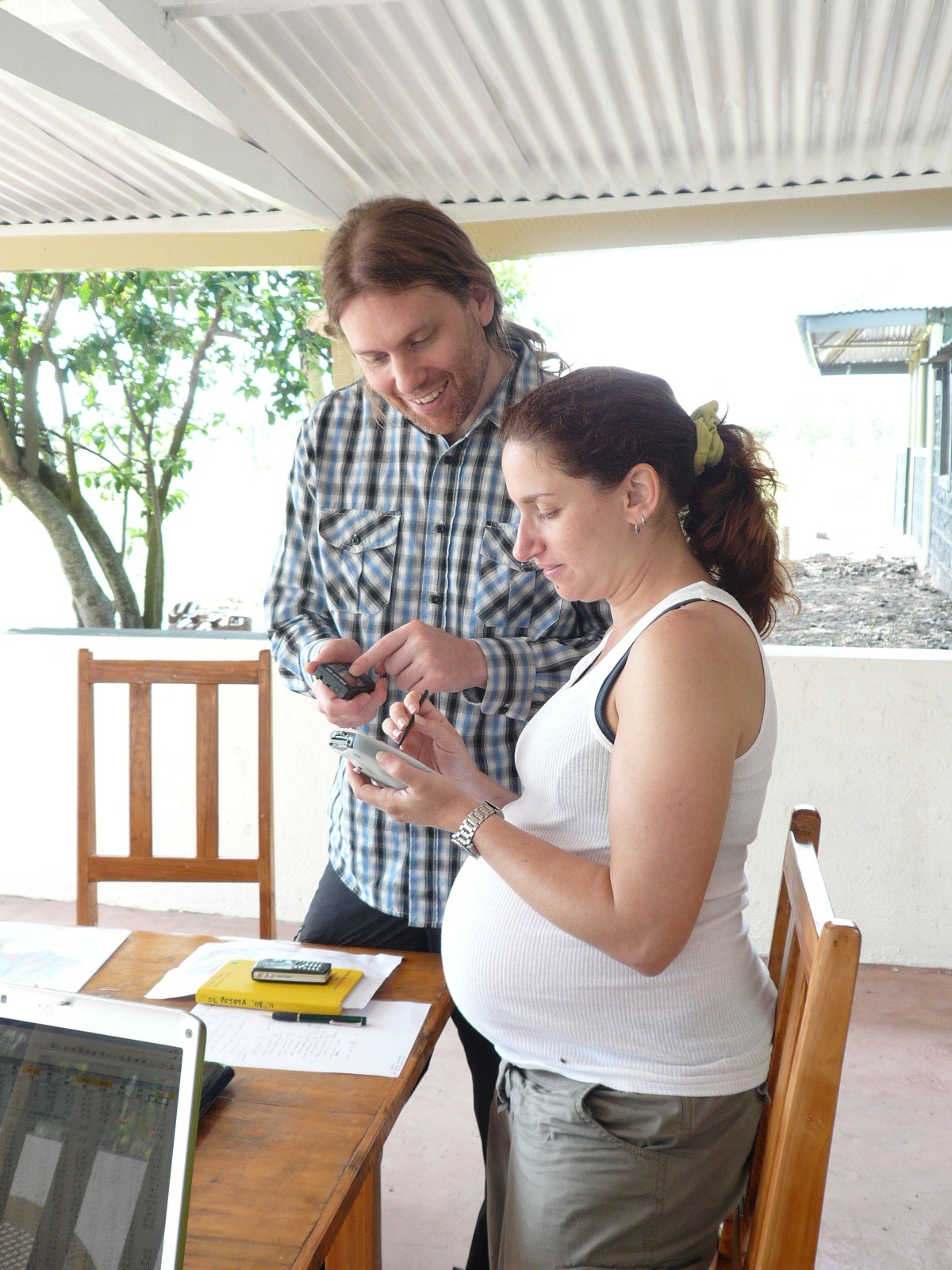
Dr. Nick Walton teaching Dr. Briana Pobiner how to use the new digital data collection system. Photo credit: Dr. Kris “Fire” Kovarovic.
_____________________________________________________________________________________________________________________
The data we collect will be used in numerous ecological analyses. The first of these is a “live-dead” analysis in which we test the hypothesis that the bone accumulations can accurately reconstruct the proportions of living species in the community. The habitat data also allows us to see if animals are dying in the habitats they’re adapted for and living in, and we’ll apply ecomorphological models to all bovid bone occurrences to predict the proportion of available habitat types and ecological niches in OPC. These results will be compared to the actual known habitat types to determine if ecomorphology provides a faithful environmental reconstruction or if it is biased against certain habitats.
A determination of the body size and predator involvement of each bone occurrence will then be used to investigate the correlations between these two potential biases and where they are responsible for similar patterns observed in the fossil record. If we find correlations between the proportion of undamaged bones and prey size or predator species, we will have identified a systematic pattern of bias that will result in an under- or over-representation of particular habitats in a palaeoenvironmental reconstruction. Ecomorphological analyses of carnivore damaged fossil assemblages thus would be similarly biased. Large carnivores are known to cause damage to or destroy skeletal elements of prey of varying sizes while feeding on them, so it is likely that some degree of bias exists, but we are unclear to what extent it affects our analyses (e.g. Haynes 1980, Pobiner 2007). If we wish to contextualize hominin evolution at a finer temporal scale, an understanding of – and possible corrections for – this bias is critical to an accurate interpretation of environmental change in the past.
Our project is intended to be a longitudinal study, and it takes many years of fieldwork to acquire the sample sizes required for analysis. Each year that we collect data we record information from bones deposited at different times in the past; fortunately, these data can be stratified according to the time of deposition on the landscape by applying weathering stage models. Time is an important variable, especially where the fossil record is concerned, so it is important for us to determine if the bone accumulations correlate to known increases or decreases in the abundances of both predator and prey species over the past 10+ years (e.g. Miller & Behrensmeyer 2005, Faith & Behrensmeyer 2006, Western & Behrensmeyer 2009), as well as in ecomorphological representations of the available habitats. OPC welcomes this study as it will offer data on changes in carnivore- and habitat-specific predation pressure over time, which may in turn help to understand temporal and spatial shifts in the living mammal biodiversity. The unique and fruitful collaborations occurring under the auspices of BONES have shown that the linkages between past and present mammalian communities are relevant to our understanding of the modern world, while simultaneously aiding the development of models used in interpreting the fossil record and our evolutionary past.
________________________________________________________
Literature Cited
Behrensmeyer, A.K. (1978). Taphonomic and ecologic information from bone weathering. Paleobiology 4, 150-162.
Behrensmeyer, A.K., Western, D. & Dechant Boaz, D.E. (1979). New persepectives in vertebrate paleoecology from a recent bone assemblage. Paleobiology 5, 12-21.
Bobe, R., Behrensmeyer, A.K. & Chapman, R.E. (2002). Faunal change, environmental variability and late Pliocene hominin evolution. Journal of Human Evolution 42, 475-497.
Faith, J.T. & Behrensmeyer, A.K. (2006). Changing patterns of carnivore modification in a landscape bone assemblage, Amboseli Park, Kenya. Journal of Archaeological Science 33, 1718-1733.
Haynes, G. (1980). Prey bones and predators: potential ecologic information from analysis of bone sites. Ossa 7, 75-97.
Kappelman, J. (1991). The paleoenvironment of Kenyapithecus at Fort Ternan. Journal of Human Evolution 20, 95-129.
Kappelman, J., Plummer, T., Bishop, L., Duncan, A., & Appleton, S. (1997). Bovids as indicators of Plio-Pleistocene paleoenvironments in East Africa. Journal of Human Evolution 32, 229-256.
Kovarovic, K. & Andrews, P. (2007). Bovid psotcranial ecomorphological survey of the Laetoli palaeoenvironment. Journal of Human Evolution 52, 663-680.
Miller, J.H. & Behrensmeyer, A.K. (2005). Skeletal distributions across time: A multivariate approach to the changing taphonomy of Amboseli Park, Kenya. Journal of Vertebrate Paleontology 25, 92A.
Pobiner, B. (2007). Hominin-Carnivore Interactions: Evidence from Modern Carnivore Bone Modification and Early Pleistocene Archaeofaunas (Koobi Fora, Kenya: Olduvai Gorge, Tanzania). PhD dissertation, Rutgers University.
Pobiner, B. & Blumenschine, R. (2003). A taphonomic perspective on the Oldowan hominid encroachment on the carnivoran palaeoguild. Journal of Taphonomy 1, 115-141.
Potts, R. (1996). Evolution and climate variability. Science 273, 922-923.
Western, D. & Behrensmeyer, A.K. (2009). Bone assemblages track animal community structure over 40 years in an African savanna ecosystem. Science 324, 1061-1064.


